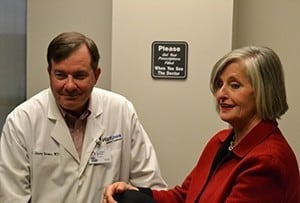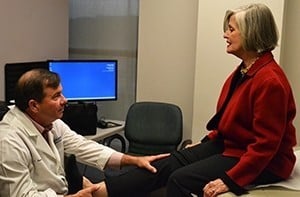Knee Replacement Gives Patient Her Life Back
| Susan Smith dealt with knee pain for years, but when it began to affect her daily activities, she knew it was time to do something.

C. Lowry Barnes, M.D., chair of the UAMS Department of Orthopaedics, sits with his patient, Susan Smith
Smith, who is the wife of G. Richard Smith, M.D., former dean of the UAMS College of Medicine, has always been an active person. Whether it’s riding a bike, hiking or ballroom dancing, she’s always been on the go. However, she eventually had to slow down because of increased knee pain.
“I was in so much pain that going down the aisle of a grocery store was really painful,” said Smith. “I had to decide whether or not I was going to walk upstairs to get something, or would it hurt too much.”
That’s when she decided to visit C. Lowry Barnes, M.D., chair of the UAMS Department of Orthopaedics and one of the region’s foremost joint replacement experts.
“Susan came in with the right attitude; she was ready to get on with her life,” said Barnes. “There were things she wanted to do that she couldn’t, and she was an absolute perfect patient.”
A year and a half removed from the procedure, Smith, who is a priest associate at Trinity Episcopal Cathedral in Little Rock, is back to life as usual and has been for a while.
“I’m going hiking in Utah in a few weeks with my husband,” Smith said with a smile. “Three years ago, that wouldn’t have happened.”
After hip- or knee-replacement surgery, Barnes said many of his patients come to him with a similar question.
“Most patients come back and ask, ‘why did I wait so long?’” Barnes said. “They didn’t realize they could get rid of their pain and get back to doing the things they want to do.”
There have been many advancements in orthopaedic surgery in the last several decades, including an average one-day hospital stay at UAMS

Barnes examines Smith following her knee-replacement surgery.
following knee replacement surgery, which Barnes said has made things better for doctors and patients.
“Things have vastly improved,” he said. “Our pain-relief strategies are much better, so patients are in less discomfort and move quicker.”
For those experiencing hip or knee pain, Barnes said interference with daily life is a key factor when considering the options.
“When you can’t do things you want to do or need to do, it’s time to talk about surgery,” he said. “Sometimes, I have patients who cannot take care of family because of the pain, and other times, it’s patients who have trouble playing golf in retirement after playing multiple times a week their entire lives.”
There are other non-surgery options that can be effective, including weight loss.
“When you stand, you put four-times your weight in stress across your knee joints,” Barnes said. “Losing 10 pounds is like losing 40 pounds to your knees, so that can help.”
Smith said she is happy with her decision and the treatment she received at UAMS.
“Dr. Barnes likes to do it perfectly, every time,” she said. “He wants fabulous outcomes for everyone and treats every patient the same.”
